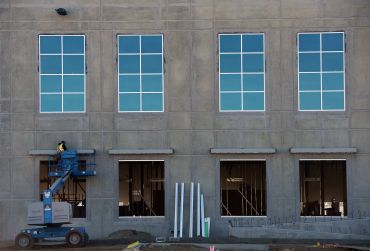As the city and real estate market continued its post-recession surge over the past year, a number of significant milestones played out under the watchful eyes—and in some cases careful direction—of the Real Estate Board of New York that will shape the future of the city for decades to come.

Of course, some initiatives became issues of contention. That’s not a big surprise in New York, where argument is its own dialect. But no one, especially REBNY President Steven Spinola, would argue the fact that the past year was characterized by great optimism and achievements.
Among the highlights: 1 World Trade Center was officially named the tallest building in the Western Hemisphere, developers broke ground at Hudson Yards, the Empire State Building was offered to the public, and, perhaps most triumphantly of all, Downtown Manhattan came into its own after a devastating storm.
“It’s a wonderful indication of what New York is able to do,” Mr. Spinola said. “It was another false prediction that the days of lower Manhattan were numbered because of [Superstorm] Sandy.”
REBNY members served on the Building Resiliency Task Force, making important changes post- Sandy that will make the city stronger in the face of another disaster, they spent countless hours giving the city feedback regarding the latest building code, and they led the efforts to reinstate the condo, co-op and J-51 abatement programs, which were upheld in Albany.
“We were anxious to do something early in 2013 to renew that program,” Mr. Spinola said regarding the abatement extensions. “Albany amazingly reached an agreement to pass a bill that both gave the extension for co-op and condo owners and J-51. … It was a major accomplishment.”
Of course, more contentious issues arose, none more notable than the Midtown east rezoning, which REBNY, Mr. Spinola and many leading real estate heavyweights had stood, and still stand, firmly behind. At one point, the initiative appeared destined to pass and perhaps become Mayor Michael Bloomberg’s crowning zoning achievement. But it wasn’t to be, at least not in 2013.
“It was terribly disappointing that it didn’t pass,” said Stephen Green of SL Green (SLG), who sits on the REBNY board of governors, echoing a sentiment that reverberated throughout the development community. “We don’t have enough new iconic buildings, and the rezoning would have created an incentive for developers like us to take a chance on older buildings at great locations.”
The proposal would have allowed developments on qualifying sites to achieve higher “earned-as-of-right” floor area ratios by contributing to a city-managed District Improvement Fund in support of public realm and infrastructure improvements or by transferring unused air rights from area landmarks.
But although the city ultimately withdrew the rezoning application prior to a City Council vote, the fight is not over for REBNY. Mr. Spinola said the public review process helped to refine the original proposal, and he believes a consensus exists between newly elected Mayor Bill de Blasio’s administration and the real estate community that a new version of the plan should be hashed out this year.
“We’ve already had discussions within REBNY and with the council and the mayor before he was sworn in. There seems to be a consensus that the issue should not be dropped and there’s a need to revisit it and to accomplish something,” Mr. Spinola said.
“In the end, it may be somewhat different from what was identified a few months ago when it didn’t move, but this is something we still want to spend a great deal of time on, looking at the mayor’s version. We look forward to seeing this plan soon and to see how quickly the city can act on it.”
At this time last year, the city still reeled from the effects of Sandy, making 2013 a year unlike others in recent memory. Statistics provided by REBNY put the damage Sandy dealt to New York City at $19 billion, with more than 305,000 housing units damaged or destroyed.
As the remarkable rebuilding efforts played out, the wrath of the storm drifted from the collective psyche of the city at large, but REBNY continued its efforts heading the recovery and preparing for the future. Its involvement in a series of initiatives changed city, state and federal regulations and policies, amending and improving codes and regulations to rebuild with greater strength and become more resilient.


